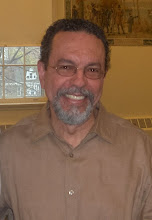I recently read Chris Washburne’s essay “Latin Music at the Apollo,” included in the book Ain’t nothing Like the Real Thing: How the Apollo Theater Shaped American Entertainment, edited by Richard Carlin and Kinshasha Holman Conwill, and published by Smithsonian Books. In his essay, Washburne tells the Apollo’s other story, the one that only a few know, namely that it was a venue for Latino cultural expression during the 1950s and 1960s just as significant as it was for African Americans.
It is amazing, I don't know how many times I've listened to Eddie Palmieri’s “El Tema del Apollo” and never connected the dots. If you play regularly in a venue you are bound to come up with a theme song. This is what Palmieri did after repeatedly playing there. Duh! So, Palmieri was a regular, as was Tito Puente, who, according to the records unearthed by Washburne, appeared more than Duke Ellington during the period between 1953 and 1965. The difference was not much—ten performances by Puente vs. nine by Ellington, but the comparative frequency is significant enough to raise the question whether this was an African American or a Puerto Rican venue as opposed to both. To settle this question we would need to know the number of times they were each asked to play and could not make it and this we will never know.
I say “Puerto Rican venue” because in East Harlem Puerto Ricans were the majority group, but, also, because it is not appropriate to refer to them as “Latino.” In Memorias de Bernardo Vega, his chronicle of Puerto Rican life in New York City, Vega uses the word “Latin” to refer to businesses in East Harlem but also notes that the predominant lifestyle in El Barrio was Puerto Rican. In Spanish Harlem, Patricia Cayo Sexton writes: “The spirited Latin music of East Harlem, pouring out from open tenement windows in every block, is Puerto Rican.” (My emphasis) In his dissertation about Vito Marcantonio, Gerald Meyer indicates that, after World War II, some Puerto Ricans referred to themselves as Latinos and to El Barrio as “el Barrio Latino,” but it is unlikely that the label signified what it has come to mean since the 1970s.
Before 1970, “Latin” was used to refer to groups with a Latin American ancestry or background. Even though they were American citizens, Puerto Ricans were Puerto Rican first, Latin second, and Americans third. This rank order begins to change during the 1960s. New York City mayor John Lindsay discovered this in 1965, after lecturing a group of Puerto Ricans about the relationship between primary and secondary identities. His auditors were offended and told the mayor they did not need to be reminded that they were Americans. Thus, “Latino” is used mostly to refer to Americans of Central, South American, and Spanish ancestry or background, and secondarily it is used to categorize those who are either residents or visitors.
The majority of Spanish-speaking musicians that played at the Apollo and the majority of the Spanish-speaking audience must have been Puerto Rican and Cuban. That they called themselves “Latin” does not justify calling them “Latino” because they were, in all likelihood, Puerto Rican and Cuban first. Labels usually match with identities but not if they are used retrospectively.
OK, let me look at a couple more pinheads now to see how many angels they house.
Come to think of it, the argument against the use of “Latino” to refer to Puerto Ricans, Cubans, et al. before 1970, can be used to object to the use of the term “African American” as well. It would be more historically appropriate to refer to blacks of that period as “Negroes” rather than African Americans, but for two reasons: 1. In their case, both labels refer to the one group and therefore carry the same descriptive connotation; 2. That descriptive connotation also has a pejorative ring, borne out of the historical context in which it was used. The label “Negro” is not offensive to all blacks, to wit, the decision of the U.S. Census Bureau to use it in the 2010 Census form to allow those who still define themselves as such to find their place in the census. But it is offensive to some and it is archaic.
Washburne claims that the stylistic changes in music during the post-war period can be described as "reflections" of social changes. The more specific claim is that Salsa was inspired by the civil rights movement. Was it? I don't know. Aside from Siembra, Justicia, the two socially aware songs in Barretto's album Together (the title song and "De donde vengo"), and Tony Pabón's La Protesta, what else is there that may be used as an example of inspiration by the civil rights movement? Um, in the album Solo, Jimmy Sabater sings (in English) about social changes related to civil rights; Cheo Feliciano sings (in Spanish) about class in “Juan Albañil;” there’s also Willie Colón’s Honra y Cultura and a few more scattered songs here and there. All of this is really after 1965. So, if the inspiration was the Civil Rights movement, it was not only minimal but also delayed.
Surely, the cultural reflection of social phenomena does not have to be immediate to be real but the time lag makes proving the connection more difficult. There is certainly a connection but the real issue is the use of the word “reflection.” When Palmieri, Barretto, and Blades were composing and recording their salsa comprometida, the Cuban Revolution still had some cachet, Nicaragua was on the throes of overthrowing Somoza, and the Puerto Rican national liberation movement was strong both in Puerto Rico and New York. Maybe that was their actual inspiration? Even so, how exactly did the songs “reflect” those phenomena and events? I know for a fact that the song “Juan González,” in the album by Rubén Blades and Pete Rodríguez, De Panamá a Nueva York, is about Ché Guevara, not about Malcolm X or César Chávez; Blades told me so at the New York club S.O.B’s one night when Celia Cruz was singing and he was hanging out at the bar. Yet, even though you know it must be about Ché, you do because the song evokes rather than reflect his life and death.
I’m sure these artists were influenced by the African American struggle but I am also certain that there was more and, in some cases, something completely different going on in their heads when they composed and recorded those “political” songs. I agree with Washburne that, to understand Salsa, we need to look at the songs, at the performance practices, and the business practices associated with the genre. But in that case we would need to distinguish the cultural product from the context of its production and this would still beg the question which aspect was a “reflection” of the Civil Rights movement. Washburne believes that salsa would not sound the way it does without the social movements connected with civil rights. Maybe. I still would like to see a demonstration of the causal relation between the Civil Rights Movement and, say, Eddie Palmieri’s decision to organize a Trombanga, as his brother Charlie called La Perfecta. I think it is safe to say that Palmieri’s decision had more to do with how Salsa eventually sounded in the 1970s than the Montgomery bus boycott. I don’t think the decision was in any way a “reflection” of any social movement of the period.
Washburne’s research clearly shows that Puerto Rican and Cuban musicians were almost as active at the Apollo, and, in some cases, more active than African Americans. The Apollo was a venue for intercultural exchange between African Americans, Puerto Ricans, Cubans, and other national groups from Latin America and the Caribbean. What I find most interesting is that this process of exchange appears to have been acceptable only under certain conditions. Why is it that Latin music programming at the Apollo experienced a boost when Symphony Sid began producing weekly shows there? Could race have been a factor? Why would Sid be in a better position to do this than Puerto Rican or Cuban entrepreneurs? In 1970, when Willie Colón performed at the Apollo, his music did not crossover well. Maybe his band sounded awful. But the explanation that survives in the record is that he was “too Latin” and “did not fit.” We all know the stories about Chano Pozo being resented by some African American musicians in Dizzy Guillespie’s band. He also was “too Latin” for them, although I don’t think the objection was expressed in those terms.
It would be naïve to think that the process of cross-cultural exchange is generally harmonious. The Willie Colón anecdote suggests that cultural exchange at the Apollo was acceptable as long as the African American component was prominent. If this is an apt characterization, and I can’t say definitively that it is, what could have been the motivation? That’s another “tema del Apollo” that needs to be addressed.
Subscribe to:
Post Comments (Atom)



No comments:
Post a Comment